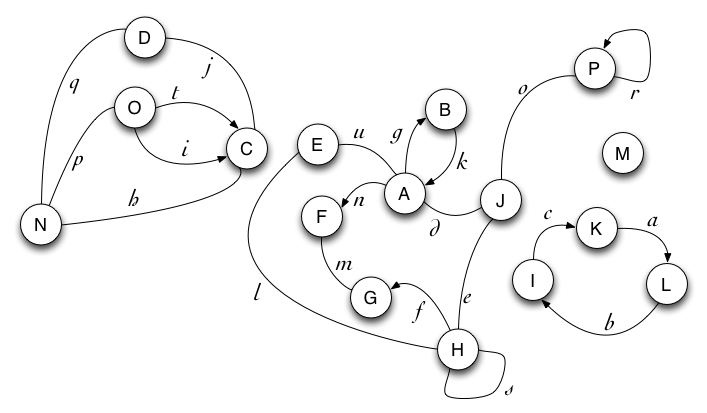Graphs
Definitions
A graph, or network is a data structure that can be used to represent general relationships among a set of elements. The elements are called vertices, nodes, or points; the relationships are called edges or arcs.

Rahter than define terms, we'll illustrate their use in the graph above:
- The order of the graph is 16, because it has 16 vertices, $A$...$P$.
- The size of the graph is 21, because it has 21 edges, $a$...$u$.
- $h$ is an undirected edge, whose endpoints are $N$ and $C$.
- $f$ is a directed edge, whose tail is $H$ and whose head is $G$.
- $t$ and $i$ are parallel edges; $g$ and $k$ are antiparallel edges.
- $r$ and $s$ are loops; all the other edges are links.
- $M$ is an isolated node.
- $J$ is an articulation point.
- $o$ is a bridge.
- $C$ and $D$ are adjacent.
- $C$ and $j$ are incident.
- $G$ has degree 2; $H$ has degree 5.
- $A$ has degree $5$, indegree 1, and outdegree 2.
- $\langle PrPoJdAgBkAuEuAnF\rangle$ is a walk of length 8, start $P$, and end $F$.
- $\langle PrPoJdA\rangle$ is an open walk.
- $\langle PrPoJeHsHeJoP\rangle$ is a closed walk.
- $\langle AdJeHfG\rangle$ is a path (open walk with no repeated vertices).
- $\langle OtChNpO\rangle$ is a cycle (closed walk of length>0 with no repeated vertices other than the first/last, and no repeated edges).
- $\langle OtChNpOiCjD\rangle$ is a trail (open walk with no repeated edges)
- $\langle AgBkAuElHeJdA\rangle$ is a tour (closed walk with no repeated edges)
- The graph is not connected; it has 4 blocks.
There are a few terms that apply only to connected graphs. Consider the block in the graph above containing vertices $\{D, C, O, N\}$ and edges $\{q, p, h, i, t, j\}$:
- $\langle OiCjDqN\rangle$ is a Hamilton Path (Hamiltonian: all the vertices).
- $\langle DqNpOtCjD\rangle$ is a Hamilton Cycle.
- $\langle OtChNpOiCjDqN\rangle$ is an Euler Trail (Eulerian: all the edges).
- The block has no Euler Tour.
Uses
Graphs can model, for example
- Chips — Electric Pathways
- Airports — Flight Paths
- Software Modules — Interfaces
- Software Functions — Calls
- Problem States — Inferences
- Chess Board Positions — Moves
- Computers — Communication Lines
- Tasks — Time Orderings
- Cities — Highways
- Countries — Borders
Kinds of Graphs
Here are a few types of graphs. The types overlap, of course; you can have a simple, directed, weighted graph.
- Connected: consists of only one block
- Simple: no parallel edges and no loops
- Multi: has parallel edges
- Undirected: none of the edges have a direction
- Directed: all of the edges have a direction
- Mixed: some of the edges have a direction and some do not
- Complete: simple, undirected, and every pair of nodes connected by an edge
- Labelled: all edges have labels
- Weighted: all edges have numeric labels
- Acyclic: there are no cycles
- Unicyclic: there is exactly one cycle
- Pancyclic: has all cycles of length 3 up to order of graph
- Tree: acyclic and connected
- List: a tree with maximum degree = 2
Implementations
Adjacency Matrix
Rows and columns are indexed by nodes; cells contain the edges (or pointers to edges, really).
| A | B | C | D | E | F | G | H | I | J | K | L | M | N | O | P | |
|---|---|---|---|---|---|---|---|---|---|---|---|---|---|---|---|---|
| A | g | u | n | d | ||||||||||||
| B | k | |||||||||||||||
| C | j | h | ||||||||||||||
| D | j | q | ||||||||||||||
| E | u | l | ||||||||||||||
| F | m | |||||||||||||||
| G | m | |||||||||||||||
| H | l | f | s,s | e | ||||||||||||
| I | c | |||||||||||||||
| J | d | e | o | |||||||||||||
| K | a | |||||||||||||||
| L | b | |||||||||||||||
| M | ||||||||||||||||
| N | h | q | p | |||||||||||||
| O | i,t | p | ||||||||||||||
| P | o | r |
Note that undirected edges appear twice. It is also possible to store only a triangular matrix.
Incidence List
For each node, store the list(s) of its outgoing edges, incoming edges, and incident undirected edges.
Adjacency List
For each node, store a list of the nodes that it is adjacent to.